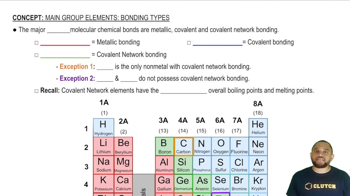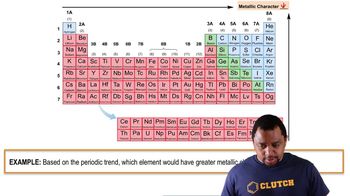A new compound is made that has a C—N bond length of 118 pm. Is this bond likely to be a single, double, or triple C—N bond?
 Verified step by step guidance
Verified step by step guidanceKey Concepts
Bond Length

Types of Covalent Bonds

Electronegativity and Bond Character

Consider the lattice energies of the following Group 2A compounds: BeH2, 3205 kJ/mol; MgH2, 2791 kJ/mol; CaH2, 2410 kJ/mol; SrH2, 2250 kJ/mol; BaH2, 2121 kJ/mol. (a) What is the oxidation number of H in these compounds?
Consider the lattice energies of the following Group 2A compounds: BeH2, 3205 kJ/mol; MgH2, 2791 kJ/mol; CaH2, 2410 kJ/mol; SrH2, 2250 kJ/mol; BaH2, 2121 kJ/mol. (c) Consider BeH2. Does it require 3205 kJ of energy to break one mole of the solid into its ions, or does breaking up one mole of solid into its ions release 3205 kJ of energy?
Consider the lattice energies of the following Group 2A compounds: BeH2, 3205 kJ/mol; MgH2, 2791 kJ/mol; CaH2, 2410 kJ/mol; SrH2, 2250 kJ/mol; BaH2, 2121 kJ/mol. (d) The lattice energy of ZnH2 is 2870 kJ/mol. Considering the trend in lattice enthalpies in the Group 2 compounds, predict which Group 2 element is most similar in ionic radius to the Zn2+ ion.
